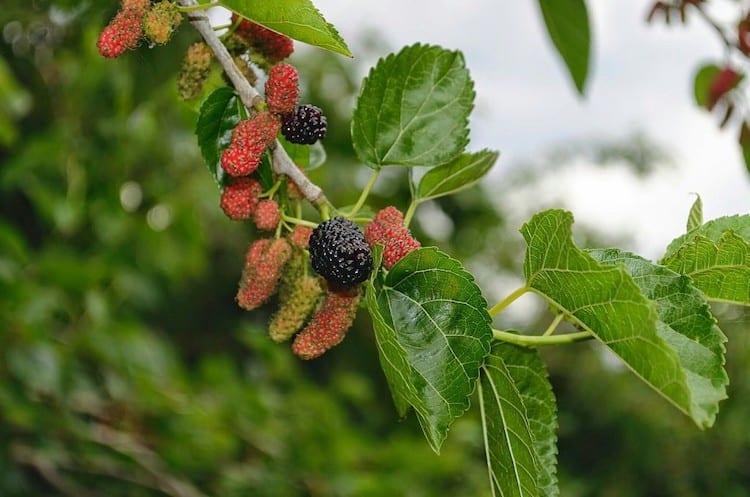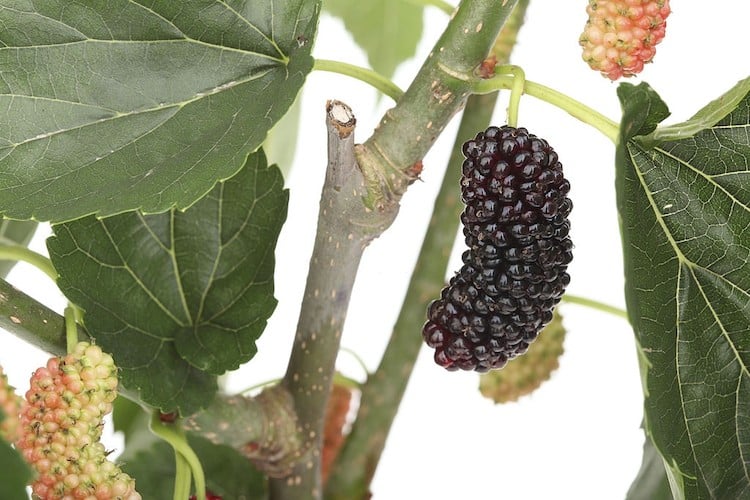Mulberry is a fruit plant that grows on deciduous trees and is highly sought after due to its low maintenance cost. Mulberries are rarely found in grocery stores, so the surest way of getting a tasty treat of it is by growing your plants.
Since most mulberries are homegrown and require adequate care during its tender age, it is pertinent you understand how to grow and care for mulberry tree.
This knowledge would guide you through the entire process of raising a young mulberry plant to a grown mulberry tree.
Read Also: Best Dwarf Banana Tree Care
Table of Contents
An Overview of Mulberry Tree
Mulberry, whose scientific name is ‘Morus spp,’ belongs to the family of Moraceae and is a deciduous fruiting tree. It is native to the Asian and North Americans.
Mulberry trees require full sunlight for growth and can be tolerant of drought. It is a non-toxic plant and, when fully mature, can grow as high as 80 feet. Pests of mulberry are caterpillars and scale insects.
Varieties of Mulberry Tree
Mulberry comes in three varieties, otherwise known as forms. These three different forms vary slightly from one another but require the same growth and care tips for them to thrive.
Various forms or varieties of mulberry are the white mulberries, the black mulberry, and the red mulberry. We shall discuss each of these varieties in detail below:
White Mulberry
White mulberry, also known as Morus alba tatarica, originated from China and are easily grown. White mulberries start as white fruits but later on grow to become dark purple. They are the tallest of the three varieties of mulberry, growing up as high as 80 feet.
White mulberry plants are easily adaptable as they can thrive in poor soil conditions and areas with partial shades. Depending on the cultivar, white mulberry can take up any shape. Some mulberry trees have a weeping habit, while others grow into a pyramid shape.
Riviera is a cultivar of white mulberry and produces fruits that juicy, fleshy and sweet. It originates from California and has a long harvest period of April down to June.
Black Mulberry
Black mulberry, scientifically known as Morus Nigra, originates from China and thrives well in warm areas. Black mulberry cannot thrive in any region whose temperature is lower than that of USDA hardiness zone 6. It also does not survive in winter.
Black mulberry trees are usually the smallest of all the three varieties of mulberry and can only grow as high as 30 feet. Growing black mulberry usually requires constant care and pruning to enable it to grow into a definite shape; otherwise, it will grow into a bush rather than a tree.
Cultivars of black mulberry include:
Kaester: This cultivar originates from LA, USA. It bears a lot of fruits that are usually up to 1.5 inches in length.
Black Persian: This bears large juicy fruits that are a little over an inch long.
Shangari-la: This cultivar is ideally grown in the Southern United States. It is native to Florida and thrives in warm areas. Shangari-la is notable for its unique foliage with humongous heart-shaped leaves. It bears large black mulberry fruits.
Red Mulberry
Red mulberry, also known as Morus rubra, is regarded as an American mulberry tree. This cultivar is native to the United States and was reportedly first grown along the Gulf Coast to Massachusetts.
Red mulberry trees thrive in warm areas, and unlike the white mulberry tree, it thrives in rich fertile soils and can grow as high as 70 feet.
Red mulberry has quite a similar appearance with black mulberry, although it has smaller buds. In recent times, red mulberry trees are being crossbred with white mulberry trees to form new cultivars.
Cultivars of the red mulberry tree are Pakistan and Russian. Pakistan originates from Pakistan and thrives in warm weather, although it can do well in winters. Pakistan bears very large fruits that measure up to 3.5 inches long.
Russian originates from China. It grows for only about 35 feet in height and is used as a windbreaker because it is very tolerant of wind. Russian cultivar is one of the hardiest cultivars of mulberry.
Read Also: How to Grow and Care for Umbrella Plant
How to Grow Mulberry Tree
Mulberry trees are best grown are home as they are usually not available in stores, and to eat and use them fresh, you need to grow them yourself.
While mulberry might require low maintenance for optimal growth, they grow at a plodding pace, especially when grown from the seedling. Mulberry seedlings take about 5 to 9 years to grow into fruits, and sometimes the seedlings do not even bear fruits.
The best option is to buy a grafted tree from a nursery that would ensure that you are getting a self-fertile mulberry plant. Grafted mulberry trees usually start fruiting between one or two years after planting.
Choosing a Suitable Planting Pot
Mulberry is best grown in small pots of about 12 to 14 inches wide and deep. Smaller pots enable mulberry tree roots to grow at a moderate pace while focusing on the growth above – the fruits.
Starting with a big pot would make the plant to focus its growth on the root. As the plant grows, you upgrade the pot one size bigger at a time.
Suitable Climate for Mulberry
Mulberry trees thrive in either warm or cold climates depending on the variety, while some tolerate both climates. While buying a grafted mulberry tree, check for which variety it is, to determine whether the climate where you want to grow, it is suitable for it.
Amount of Sunlight Needed
The mulberry tree thrives in plenty of sunlight. It requires plenty of sunlight to grow and bear fruits. Therefore, you should grow your mulberry plant in a position that allows enough day sunlight and provides shade during summer.
Soil Type
Good soil for a mulberry tree is one that is rich in loamy and slightly acidic or neutral in pH. Mulberry trees also thrive in soils that are fertile and rich in compost or manure.
If you are growing a mulberry tree in a pot, ensure to use well-draining potting soil, such as a soilless potting mix. The blockage of water drainage should not be encouraged.
Watering Mulberry Tree
During the first few months of planting a mulberry tree, deep regular watering is to be practiced. After a few weeks of planting, when the tree has been established, you can start watering the tree moderately.
If you are growing a mulberry tree in a cool climate, you would have to reduce watering during winter. But water regularly and keep the soil moist during summer.
How to Care For Mulberry Tree
Fertilizer Application
To ensure optimum growth and development of the mulberry tree, apply fertilizers either on the soil or directly on the tree- as liquid fertilizer, on an interval of 7 to 10 days.
Pruning Mulberry Trees
Pruning is essential for mulberry trees to keep them from growing into a bush. Mulberry trees grown in pots do not require so much pruning, unlike those grown in the ground. Mulberry trees are usually pruned in winter when the plant is not growing or at the end of the fruiting season.
Routine pruning can also be carried out to get rid of dead or diseased branches.
Pests and Diseases
Mulberry plants suffer from diseases such as mildew, root rot, and leaf spot. You can prevent the incidence of these diseases by not overwatering the plant and ensuring proper drainage.
Common pests of the mulberry tree are whiteflies, thrips, mealy bugs, spider mites, and scales. These pests affect the growth of mulberry trees.
Mulberry Fruit Covering
Birds love to feed on mulberry fruits because they are one of their favorite fruits. To avoid a constant visit from birds, you should cover the fruits.
Read Also: How to Care for Bottle Brush Tree
Conclusion
The mulberry tree is quite easy to grow as it requires little maintenance. After growing and caring for a mulberry tree, you should expect to harvest its fruits from late spring to late summer.








Lusayu R Cisco
Thanks for the information provided. I want to know if I can ship the mulberry tree to another country other than the us for planting? Do they grow from seeds also?